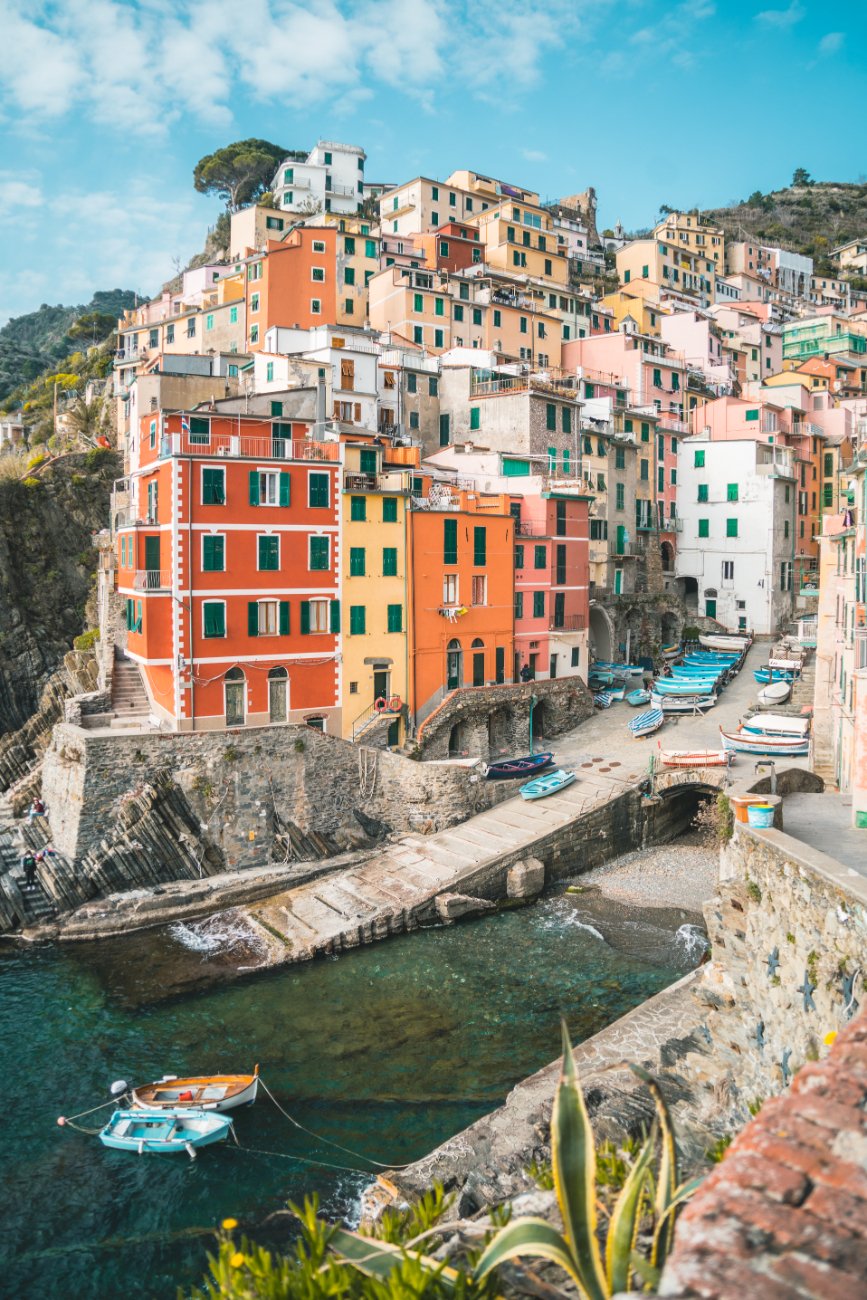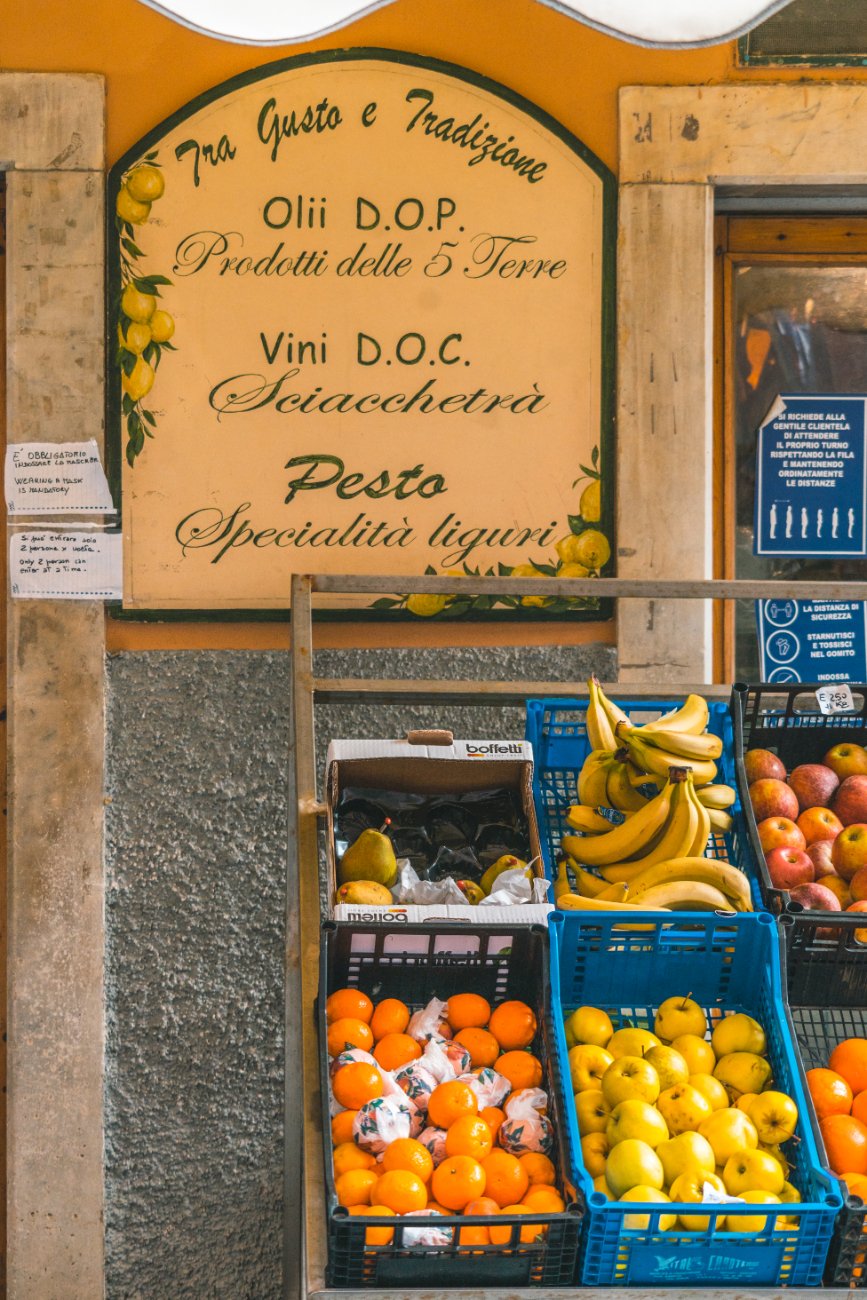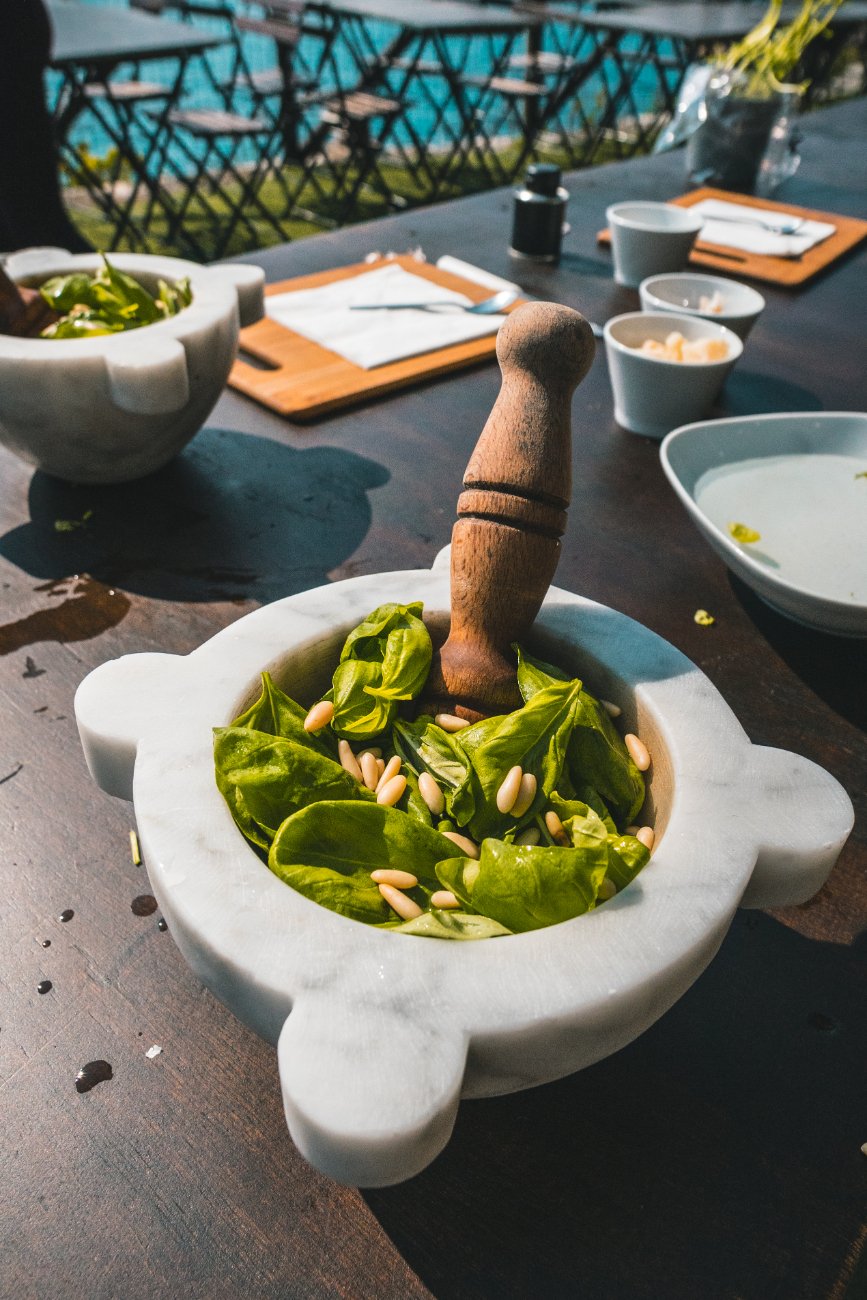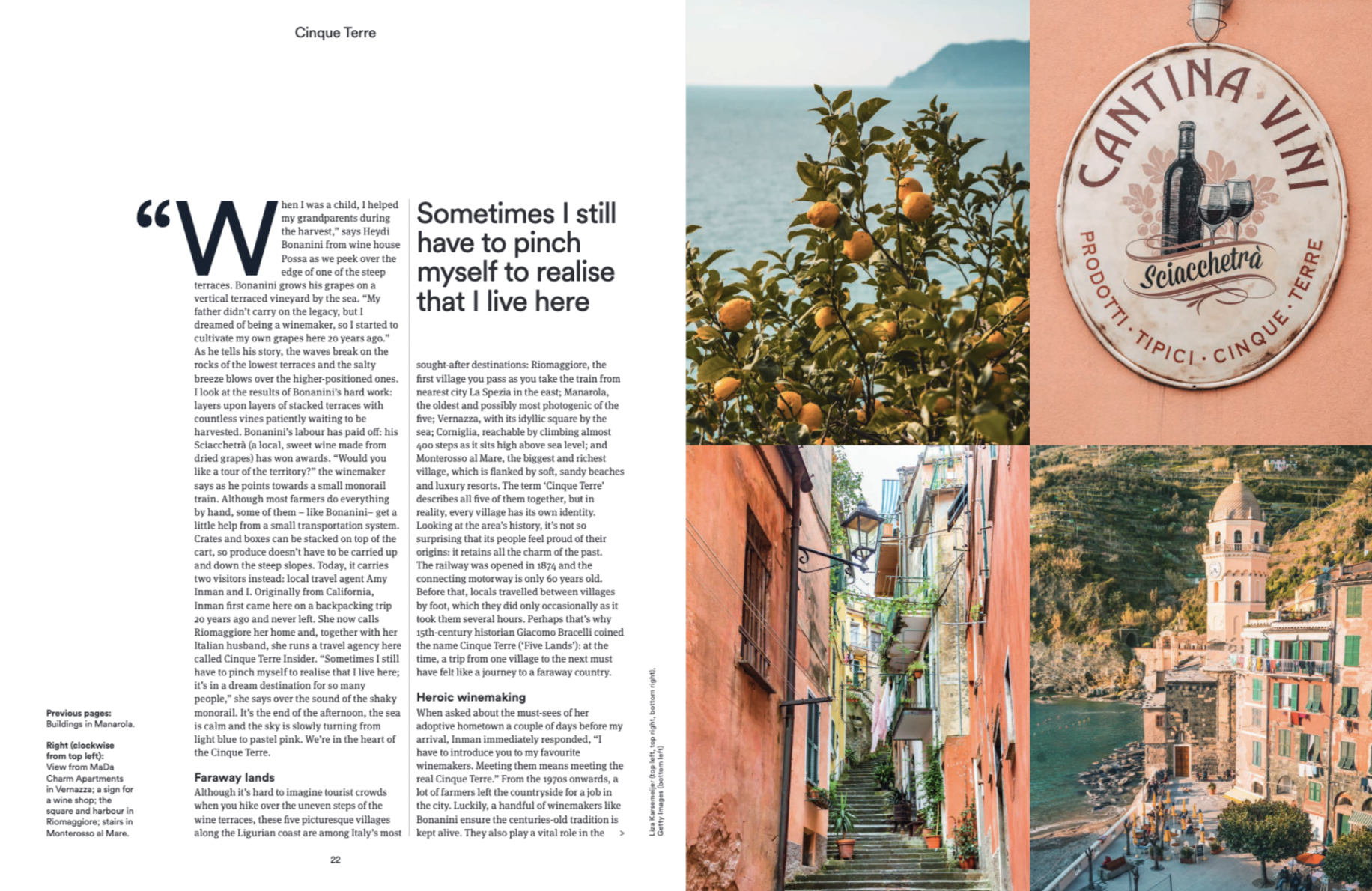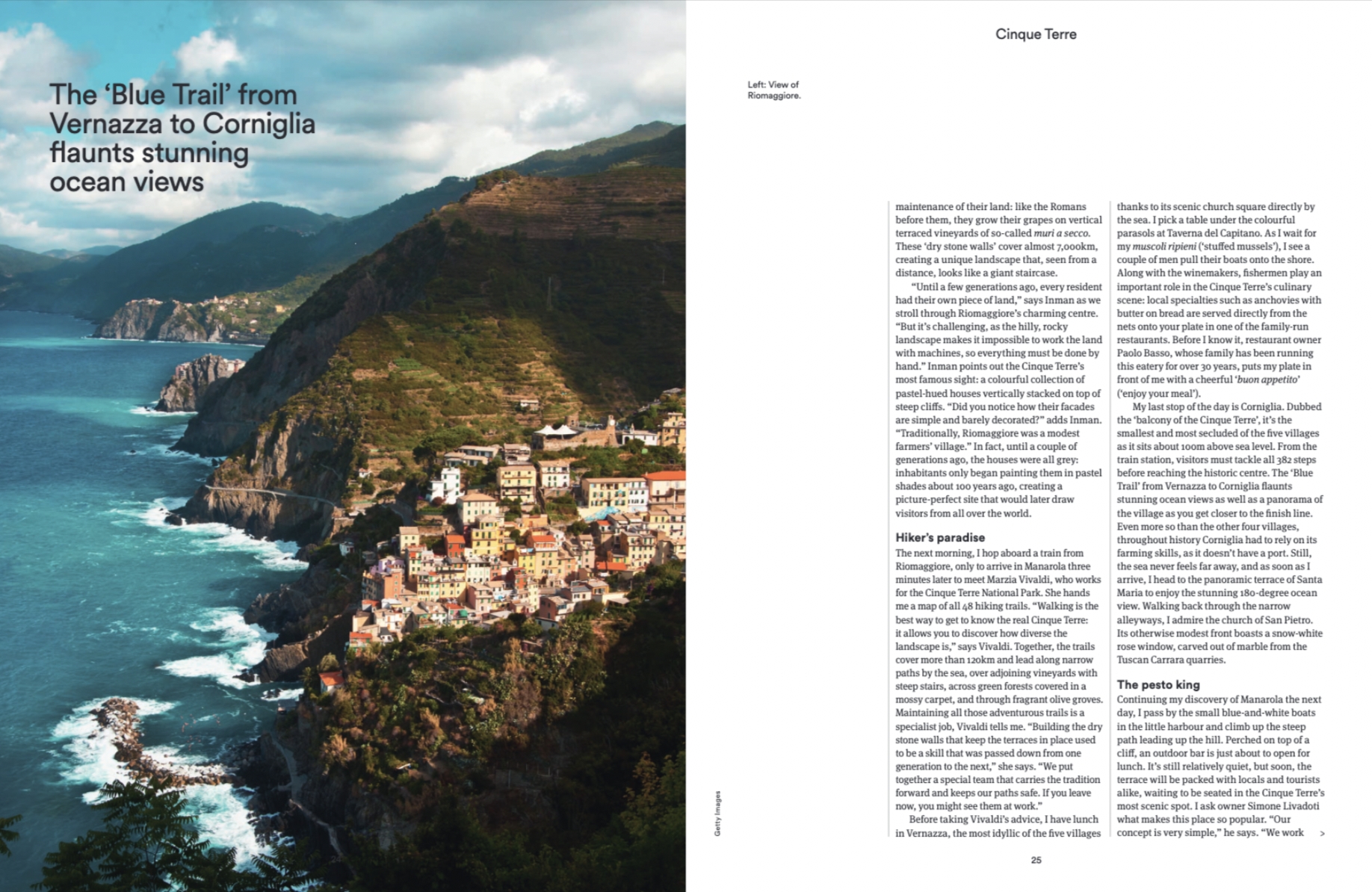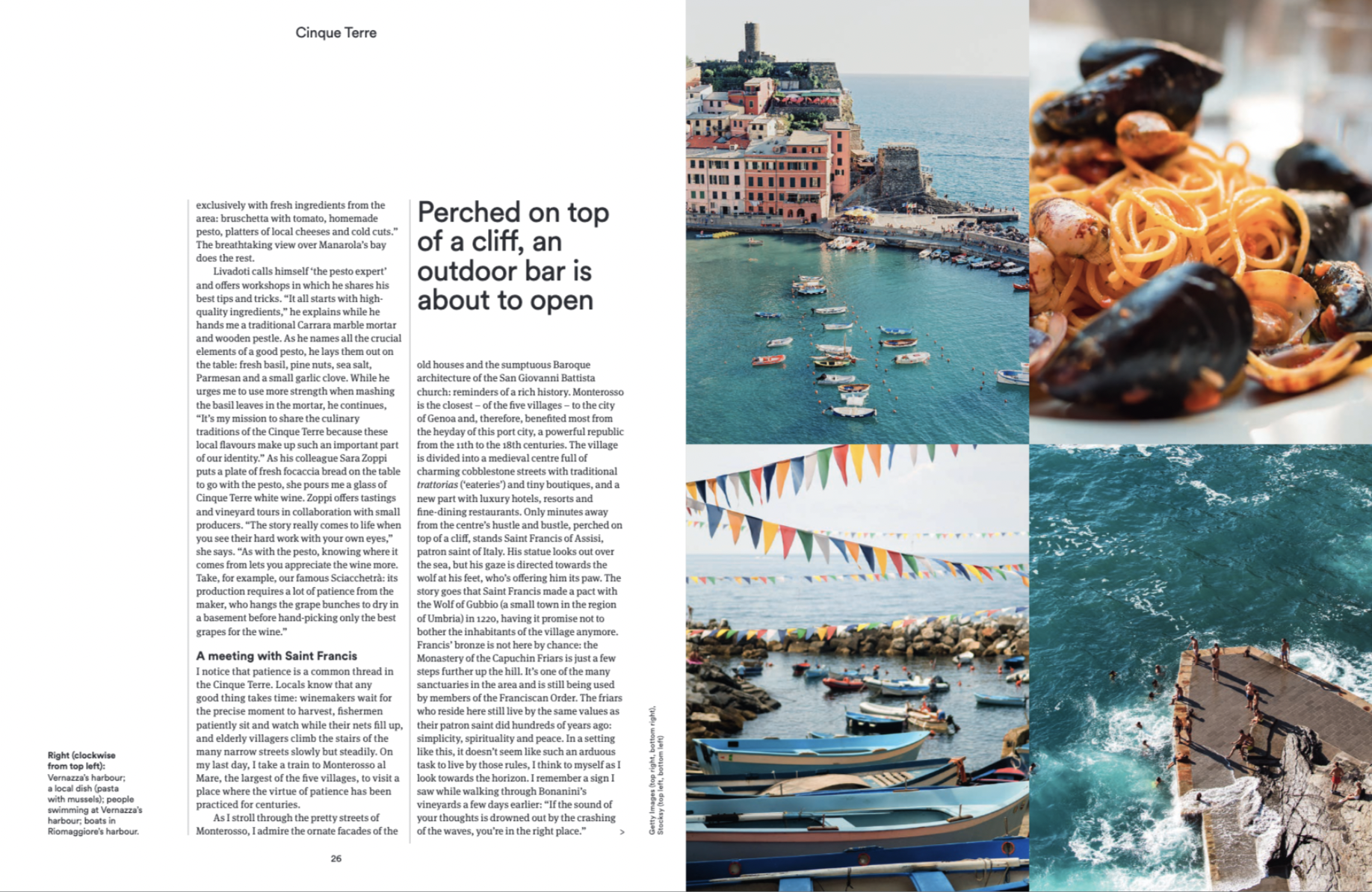Slow food & wine in the Cinque Terre
One of Italy’s most popular destinations, the towns of the Cinque Terre are a surprisingly wholesome environment for hiking enthusiasts and lovers of slow food and wine alike.
Originally published in: Holland Herald, November 2021 (see pdf below). Text & photos by Liza Karsemeijer.
“When I was a child, I helped my grandparents during the harvest,” says Heydi Bonanini from wine house Possa as we peek over the edge of one of the steep terraces. He cultivates his grapes on a vertical terraced vineyard by the sea. “My father didn’t carry on the legacy, but I dreamed of being a winemaker, so I started to cultivate my own grapes here 20 years ago.” As he tells his story, the waves break on the rocks of the lowest terraces and the salty breeze blows over the higher-positioned ones. I look at the results of Heydi’s hard work: layers and layers of stacked terraces with countless vines patiently waiting to be harvested. Heydi’s labour has paid off: his Sciacchetrà (a local, sweet wine made from dried grapes) has won awards. “Would you like a tour of the territory?” the winemaker points toward a small monorail train. Although most farmers do everything by hand, some of them – like Possa – get a little help from a small transportation system. Crates and boxes can be stacked on top of the cart so produce doesn’t have to be carried up and down the steep slopes. Today it carries two visitors instead: local travel agent Amy Inman and myself. Originally from California, Amy first came here on a backpacking trip 20 years ago and has never left. She now calls Riomaggiore her home and runs a travel agency called Cinque Terre Insider with her Italian husband. “Sometimes I still have to pinch myself that I really live here. It’s in a dream destination for so many people,” she says over the sound of the shaky monorail. It’s the end of the afternoon, the sea is calm and the sky is slowly turning from light blue to pastel pink. We’re in the heart of the Cinque Terre.
Faraway lands
Although it’s hard to imagine tourist crowds when you hike over the uneven steps of the wine terraces, these five picturesque towns along the Ligurian coastline are among Italy’s most sought-after destinations: Riomaggiore, the first town you pass as you take the train from nearest city La Spezia in the east; Manarola, the oldest and possibly most photogenic of the five; Vernazza, with its idyllic square by the sea; Corniglia, reachable by climbing almost 400 steps as it sits high above sea level; and Monterosso, the biggest and richest village, which is flanked by soft, sandy beaches and luxury resorts. The term ‘Cinque Terre’ describes all five of them together, but in reality, every town has its own identity. Looking at the area’s history, it’s not so surprising its people feel proud of their specific birth town: the railway was opened in 1874 and the connecting motorway is only sixty years old. Before that, locals travelled between villages by foot, which they did only occasionally, as it took them several hours. Maybe that’s why 15th-century historian Giacomo Bracelli coined the name Cinque Terre (‘Five Lands’): at the time, a trip from one village to the next must have felt like a journey to a faraway country.
Heroic winemaking
When asked about the must-sees of her adoptive home town a couple of days before my arrival, Amy immediately responded: “I have to introduce you to my favourite wine makers: meeting them means meeting the real Cinque Terre.” From the seventies onwards, many farmers left the countryside for a job in the city. Luckily, a handful of wine makers like Heydi ensure the centuries-old tradition is kept alive. They also play a vital role in the maintenance of their land: like the Romans before them, they grow their grapes on vertical terraced vineyards of so-called muri a secco. These dry stone walls cover almost 7,000km, creating a unique landscape which, seen from a distance, looks like a giant staircase.
“Until a few generations ago, every resident had their own piece of land,” says Amy as we stroll through Riomaggiore’s charming centre, “but it’s challenging, as the hilly, rocky landscape makes it impossible to work the land with machines, so everything must be done by hand.” Amy points out the Cinque Terre’s most famous sight: a colourful collection of pastel-hued houses vertically stacked on top of steep cliffs. “Did you notice how their facades are simple and barely decorated? Traditionally, Riomaggiore was a modest farmers village.” In fact, until a couple of generations ago, the houses were all grey: inhabitants only began painting them in pastel shades about 100 years ago, creating a picture-perfect site that would later draw visitors from all over the world.
Hiker’s paradise
The next morning, I hop aboard a train from Riomaggiore, only to arrive in Manarola three minutes later to meet Marzia Vivaldi. She works for the Cinque Terre National Park and hands me a map of all 48 hiking trails. “Walking is the best way to get to know the real Cinque Terre: it allows you to discover how diverse the landscape is,” she states. Together, the trails cover more than 120km and lead along narrow paths by the sea, over adjoining vineyards with steep stairs, across green forests covered in a mossy carpet, and through fragrant olive groves. Maintaining all those adventurous trails is a specialist job, Marzia tells me: “Building the dry stone walls that keep the terraces in place used to be a skill that was passed down from one generation to the next. We put a together a special team that carries the tradition forward and keep our paths safe.” With a smile, she adds: “If you leave now you might see them at work.”
Before taking Marzia’s advice, I decide to have lunch in Vernazza, the most idyllic of the five towns thanks to its scenic church square directly by the sea. I pick a table under the colourful parasols at La Taverna del Capitano. As I wait for my muscoli ripieni (stuffed mussels), I see a couple of men pull their boats on the shore. Along with the winemakers, fishermen play an important role in the Cinque Terre’s culinary scene: local specialties such as anchovies with butter on bread are served directly from the nets onto your plate in one of the family-run restaurants. Before I know it, restaurant owner Paolo Basso, whose family has been running this eatery for over 30 years, puts my plate in front of me with a cheerful “buon appetito!”
My last stop of today is Corniglia. Dubbed the ‘balcony of the Cinque Terre,’ it’s the smallest and most secluded of the five towns, as it sits about 100m above sea level. From the train station, visitors have to conquer all 380 steps before reaching the historic centre, but I opted for a different route today and arrived by foot. The ‘blue trail’ from Vernazza to Corniglia flaunts stunning ocean views as well as a panorama of the town as you get closer to the finish line. Even more than the other four villages, Corniglia had to rely on its farming skills throughout history, as it doesn’t have a port. Still, the sea never feels far away: as soon as I arrive, I head to the panoramic terrace of Santa Maria and enjoy the stunning 180-degree ocean view. Walking back through the narrow alleyways, I admire the church of San Pietro: its otherwise modest front boasts a snow-white rose window, carved out of marble from the Tuscan Carrara quarries.
The pesto king
Continuing my discovery of Manarola the next day, I pass by the small, blue and white boats in the little harbour and climb up the steep path leading up the hill. Perched on top of a cliff, a small open-air bar is just about to open for lunch. It’s still relatively quiet, but soon the terrace will be packed with locals and tourists alike, waiting to be seated in the Cinque Terre’s most scenic spot. I ask owner Simone Livadoti what makes this place so popular. “Our concept is incredibly simple,” he says. “We work exclusively with fresh ingredients from the area: bruschetta with tomato, homemade pesto, platters of local cheeses and cold cuts.” The breathtaking view over Manarola’s bay does the rest.
Livadoti calls himself ‘the pesto expert’ and offers workshops in which he shares his best tips and tricks. “It all starts with high-quality ingredients,” he explains while he hands me a traditional Carrara marble mortar and wooden pestle. As he names all the crucial elements of a good pesto, he lays them out on the table: fresh basil, pine nuts, sea salt, Parmesan, and a small garlic clove. While he urges me to use more strength when mashing the basil leaves in the mortar, he continues, “It’s my mission to share the culinary traditions of the Cinque Terre, because these local flavours make up such an important part of our identity.” As his colleague Sara Zoppi puts a plate of fresh focaccia (Ligurian flat bread) on the table to go with the pesto, she pours me a glass of Cinque Terre white wine. Zoppi offers tastings and vineyard tours in collaboration with small producers. “The story really comes to life when you see their hard work with your own eyes. As with the pesto, knowing where it comes from lets you appreciate the wine more,” she says. “Take for example our famous Sciacchetrà: its production requires a lot of patience from the maker, who hangs the grape bunches to dry in a basement before hand-picking only the best grapes to make the wine.”
A meeting with Saint Francis
I begin to notice patience is a common thread in the Cinque Terre. Locals know that any good thing takes time: wine makers wait for the exact right moment to harvest, fishermen patiently sit and watch while their nets fill up, and elderly villagers climb the stairs of the many narrow streets slowly but steadily. On my last day, I take a train to Monterosso al Mare, the largest of the five towns, to visit a place where the virtue of patience has been practiced for centuries.
As I stroll through the streets of Monterosso, I admire the ornate facades of the old houses and the sumptuous Baroque architecture of the San Giovanni Battista Church: reminders of a rich history. Monterosso is closest to the city of Genoa and, therefore, benefited most from the heyday of this port city, a powerful republic from the 11th to the 18th century. The village is divided into a medieval centre full of charming cobblestoned streets with traditional trattoria’s and tiny boutiques, and a new part with luxury hotels, resorts, and fine dining restaurants.
Only minutes away from the centre’s hustle and bustle, perched on top of a cliff, stands Saint Francis, patron saint of Italy. His statue looks out over the sea, but his gaze is directed towards the dog at his feet, who’s offering him its paw. The story goes that Francis made a pact with the Wolf of Gubbio (a small city in the region of Umbria) in 1220, having it promise not to bother the inhabitants of the village anymore. Francis’ bronze is not here by chance: the convent of the Capuchin Franciscans is just a few steps further up the hill. It’s one of the many sanctuaries in the area and is still being used by members of the Franciscan Order. The friars who reside here still live by the same values as their patron saint did hundreds of years ago: simplicity, spirituality, and peace. In a setting like this, it doesn’t seem such an arduous task to live by those rules, I think to myself as I look towards the horizon. I remember a sign I saw while walking through Heydi’s vineyards a few days earlier: “If the sound of your thoughts is drowned out by the crushing of the waves, you’re in the right place.”
Places to stay
Cinque Terre D’Amare, Riomaggiore
These fully equipped apartments boast beautiful sea view terraces and even a lush, private garden with your very own lemon tree. cinqueterredamare.com
MaDa Charm Apartments, Vernazza
Perfect for a romantic break, these luxury rooms include spacious designer bathrooms. The Terrace Suite offers the best view of Vernazza, looking out over the square and the sea. madacharm.it
La Polena, Vernazza
This charming B&B owned by local couple Federico and Virginia, is a great choice for families or anyone looking for the best value for money. There’s even a shared roof terrace. lapolenavernazza.com
Hotel Firenze e Continentale, La Spezia
Traveling for business or simply looking for a convenient base for your trip? Located right next to La Spezia station, this hotel offers modern rooms and a hip cocktail bar with a vertical garden. hotelfirenzecontinentale.it
Places to eat & drink
La Taverna del Capitano, Vernazza
Be sure to try the catch of the day at this delightful restaurant on the church square. Their tegame di Vernazza (a local specialty with fresh anchovies) is the best in town. tavernavernazza.com
Locanda Tiabuscion, Volastra
The hiking trail that leads from Manarola to Corniglia passes by this local favourite that serves traditional dishes with a twist. If you want to splurge, be sure to try their tasting menu. locanda-tiabuscion.business.site
Torre Aurora, Monterosso al Mare
Perfect for a glass of wine or a Spritz at sundown, this ancient watchtower now functions as a bar and restaurant. torreauroracinqueterre.com
Places to shop
Fabbrica d’Arte, Monterosso al Mare
This family business creates handmade ceramics with an element of the Cinque Terre in every piece: tiles with pastel-coloured houses, ocean-hued espresso cups, and anchovy-shaped serving platters. fabbricadarte.com
Lanapo, Monterosso al Mare
Designer Federica Napoletano took a little piece of her home city Milan with her when she opened this tiny boutique. Her skilfully handcrafted sandals are perfect for strolling the villages’ cobblestoned streets. lanapo.it
Gocce di Byron, Vernazza
Named after Lord Byron, who fell in love with the region, this local perfume maker offers five signature scents that will keep reminding you of the Cinque Terre once you’re back home. goccedibyron.it
To do
Take a tour
An official guide of the Cinque Terre National Park, Sabrina Ferdeghini knows all the ins and outs and will enthusiastically tell you about the villages’ natural beauty as well as their history and food culture.
Hike the Via dei Santuari
During this 25km-long hike, you’ll discover all five sanctuaries of the Cinque Terre – and sleep in them along the way. If this spiritual but strenuous route sounds too challenging, there are hiking trails for all levels within three other themes: ancient settlements, nature, and vineyards.
Go diving
The protected marine area is home to dolphins, barracudas, conger eels, and lobsters. The National Park offers five stunning diving itineraries, varying from beginner to expert level (there’s even one for disabled divers). parconazionale5terre.it
Holland Herald, November 2021
Text & photos by Liza Karsemeijer
